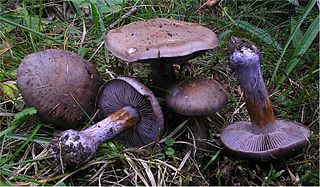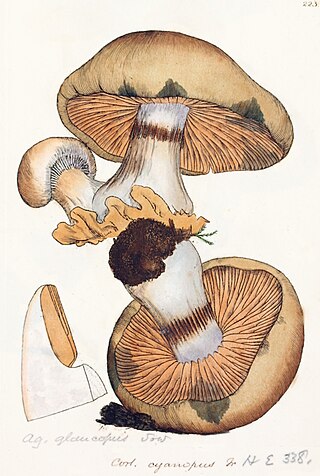
The Cortinariaceae are a large family of gilled mushrooms found worldwide, containing over 2100 species. The family takes its name from its largest genus, the varied species of the genus Cortinarius. Many genera formerly in the Cortinariaceae have been placed in various other families, including Hymenogastraceae, Inocybaceae and Bolbitiaceae.

Phlegmacium triumphans, also known as the birch webcap, or yellow girdled webcap is a basidiomycete mushroom in the family Cortinariaceae. It is found in Europe and regarded as edible by some authorities, although others call it suspect and it resembles inedible species.

Cortinarius varius, also known as the contrary webcap, is a basidiomycete mushroom of the genus Cortinarius. The mushroom has orangish-yellow caps that reach up to 10 cm (3.9 in) in diameter, and thick club-shaped stems up to 10 cm (3.9 in) long.

Thaxterogaster purpurascens is a species of mushroom producing fungus in the family Cortinariaceae. It is commonly known as the bruising webcap.

Cortinarius infractus, commonly known as the sooty-olive Cortinarius or the bitter webcap, is an inedible basidiomycete mushroom of the genus Cortinarius. The fungus produces sooty-olive fruit bodies with sticky caps measuring up to 13 cm (5.1 in) in diameter. The fruit bodies contains alkaloids that inhibit the enzyme acetylcholinesterase.

Cortinarius hemitrichus, also known as the frosty webcap, is a basidiomycete mushroom of the genus Cortinarius. Young mushrooms are characterized by their brown cone-shaped caps covered with dense white fibrils.

Cortinarius anomalus, also known as the variable webcap, is a basidiomycete fungus of the genus Cortinarius. It produces a medium-sized mushroom with a grayish-brown cap up to 5 cm (2 in) wide, gray-violet gills and a whitish stem with pale yellow belts below. The mushroom grows solitarily or in scattered groups on the ground in deciduous and coniferous forests. It is found throughout the temperate zone of the northern hemisphere.

Cortinarius orellanus, commonly known as the fool's webcap or fools webcap, is a species of deadly fungus in the family Cortinariaceae native to Europe. Within the genus it belongs to a group known as the Orellani, all of which are highly toxic—eating them results in kidney failure, which is often irreversible. The mushroom is generally tan to brown all over.

Cortinarius camphoratus, commonly known as the goatcheese webcap, is an agaric fungus in the family Cortinariaceae. The fungus is found in Europe and North America, where its fruit bodies (mushrooms) grow on the ground in a mycorrhizal association with spruce and firs in coniferous forests. Mushrooms are characterized by pale blue lilac colors when young, and a strong distinctive odor. Sources disagree as to the edibility of the mushroom, but they are generally not recommended for eating.

Thaxterogaster pluvius is a species of fungus in the family Cortinariaceae.

Thelephora anthocephala is a species of coral fungus in the family Thelephoraceae. It was originally described as new to science in 1786 by French botanist Jean Baptiste François Pierre Bulliard, who placed it in the genus Clavaria. Elias Fries transferred it to Thelephora in his 1838 work Epicrisis Systematis Mycologici.

Cortinarius cyanites is a basidiomycete fungus of the genus Cortinarius native to Europe.

Phlegmacium glaucopus is a species of fungus in the family Cortinariaceae. It is commonly known as the blue-foot webcap.

Calonarius splendens is a species of fungus in the family Cortinariaceae. It is commonly known as the splendid webcap. The species is native to Europe where it has been implicated in poisonings resulting in kidney failure, though with milder symptoms than other deadly webcaps.
Aureonarius controversus is a species of fungus in the family Cortinariaceae.

Lactarius trivialis is a species of mushroom belonging to the genus Lactarius. The fungus is most commonly found in Scandinavia. The colour of the mushroom's cap can range from a light brown colour, to dark purple. The species has a total of five subtaxa. It was discovered and first recorded in the year 1838 by Elias Magnus Fries, in his book, Epicrisis Systematis Mycologici.
Aureonarius is a genus of fungi in the family Cortinariaceae.
Austrocortinarius is a genus of fungi in the family Cortinariaceae.

Cystinarius is a genus of fungi in the family Cortinariaceae.
Mystinarius is a genus of fungi in the family Cortinariaceae.
















